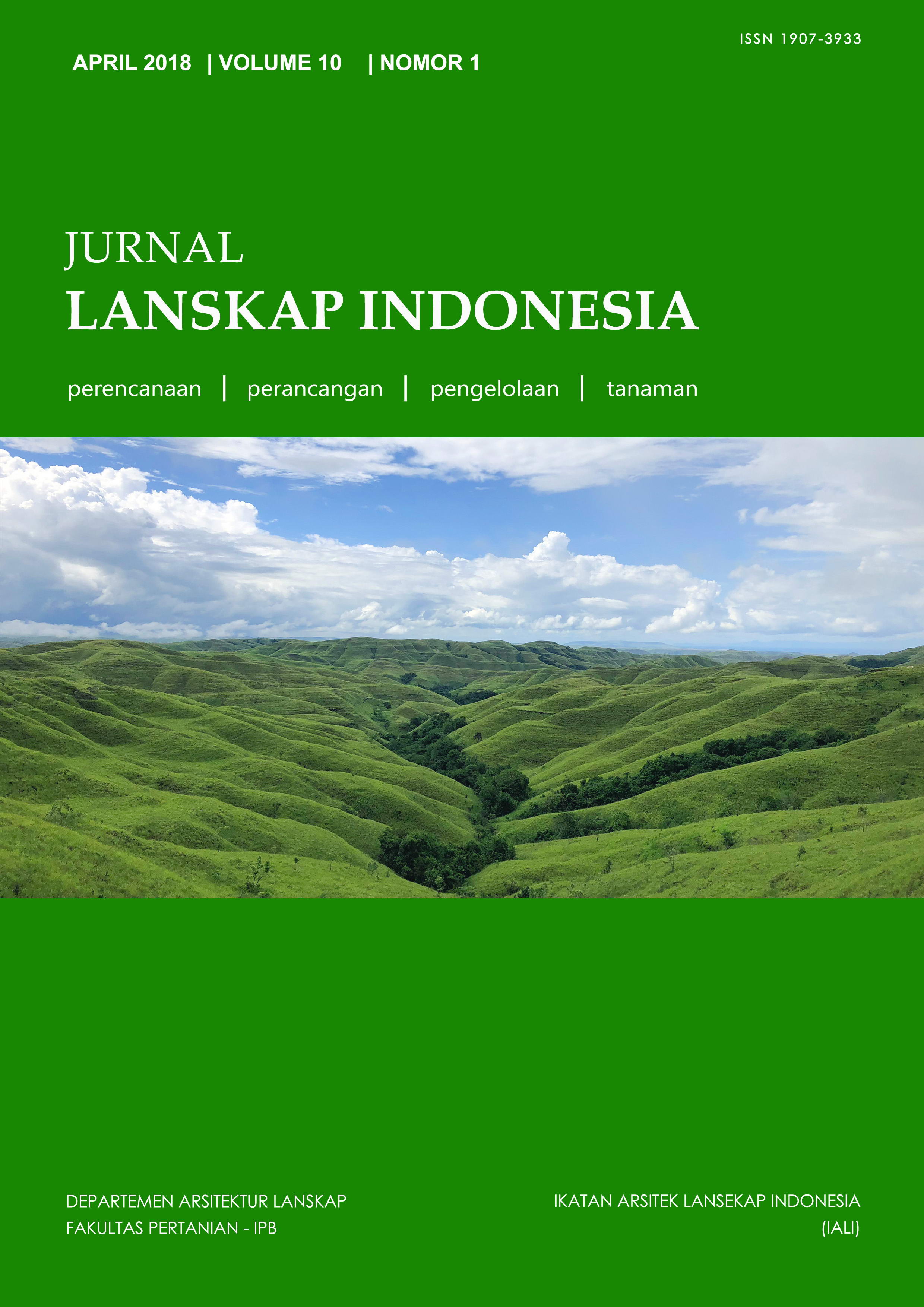DEVELOPING PLANT TOLERANCE INDICATOR TO AIR POLLUTION, CASE STUDY IN KRAKATAU INDUSTRIAL ESTATE CILEGON CITY, INDONESIA
Abstract
Plant tolerance against air pollutants from industrial estate can be assessed based on the change of physiological parameters calculated according to APTI (Air Pollution Tolerance Index by Singh). However, based on previous research, APTI formulation was less accurate, the results obtained between macroscopic and physiological observations are not always sync. Additional physiological parameters, i.e. total carbohydrates as main product of photosynthesis process was need to be examined. Therefore, purpose of this study were to examine the physiological parameters that indicate the level of tolerance of plants sensitivity to air pollution and to analyze the level of tolerance of tree species to air pollution in industrial estate. The method used in this research were survey method, along with macroscopic parameters (leaf area, leaf number, and leaf hue), microscopic parameters (stomatal density, leaf and palisade thickness) and physiological parameters (ascorbic acid content, total chlorophyll, leaf pH, water content, and total carbohydrate)observation of tree species which exposed to pollution and non-pollution (control). The results of this research showed that total carbohydrate as an additional parameter affected the level of tolerance by 49.2% and thus modified the APTI formulation and changed the classification range of plants tolerance. Results showed that the tolerant plants were Polyalthia longifolia Sonn.,Polyalthia fragrans (Dalzell) Hook. f. & Thomson, Erythrina crista-galli L., and Casuarina junghuhniana Miq.; moderate tolerance were Hibiscus tiliaceus L., Samanea saman (Jacq.)Merr. and Acacia auriculiformis A. Cunn. ex Benth; and intolerant were Leucaena leucocephala (Lam.) de Wit, Pterocarpus indicus Wild., and Swietenia mahagoni L.
Downloads
References
Arnon. 1949. Copper enzymes in isolated chloroplast: polyphenol oxidase in Beta vulgaris. Plant Physiol 24:1-15.
Bora M, Joshi N. 2014. A study on variation in biochemical aspect of different tree species with tolerance and performance index. The BioscanAn Intl Quarterly J Life Sci 9:59-63.
Carter GA, Knapp AK. 2001. Leaf optical properties in higher plants: Linking spectral characteristics to stress and chlorophyll concentration. American J Botany 84:677-684.
Dahlan EN. 1995. Effects of Air pollutants on plant leaves. Final Report for Osaka Gas Foundation. Bogor: IPB.
Krakatau Industrial Estate Cilegon [KIEC]. 2014. Laporan hasil pengujian udara ambien dan debu jatuh di Kawasan Industri. Laboratorium Lingkungan Krakatau Steel Cilegon.
Kovacs. 1992. Trees as biological indicators. In: Biological indicators in environmental protection. Kovacs, M. (ed), Ellis Horwood, New York.
Kozlowski TT, Mudds JB. 1975. Response of plants to air pollution. Academic Press, New York.
Liu YJ, Ding H. 2008. Variation in air pollution tolerance index of plant near a steel factory: implications for landscape-plant species selection for industrial area. Wseas Trans Enviro Develop 4:24-32.
Masuko T, Minami A, Iwasaki N, Majima T, Nishimura SI, Lee YC. 2005. Carbohydrate analysis by a phenol-sulfuric acid method in microplate format. Analytic Biochem339:69-72.
Moretto R, Sandrin CZ, Itaya NM, Domingos M, Figueiredo-Ribeiro RCL. 2009. Fructan variation in plants of Loliummultiflorum ssp. italicum ‘Lema’ (Poaceae) exposed to an urban environment contaminated by high ozone concentrations. In: Benkeblia N, Shiomi N.(Eds.). Proceedings of the Sixth International Fructan Symposium. Dynamic Biochemistry, Process Biotechnology and Molecular Biology 3(Special Issue 1), pp.1–9.
Oguntimehin I, Kondo H, Sakugawa H. 2010. The use of sunpatiens (Impatiens spp.) as a bioindicator of some simulated air pollutants-using an ornamental plant as bioindicator. Chemosphere81:273-281.
Pandey J, Agrawal M. 1994. Evaluation of air pollution phytotoxicity in seasonally dry tropical urban environment using three woody perennials. New Phytol126: 53-64.
Rachmat RS. 2014. Protes masalah pencemaran lingkungan, warga Ciwandan duduki pintu gerbang pemkot Cilegon [online]. [download 2014 August 27]. Available at: http://www.beritacilegon.com/index.php/berita-cilegon/cilegon-raya/5391-perotes-masalah-pencemaran-lingkungan,-warga-ciwandan-duduki-pintu-gerbang-pemkot-cilegon.html?device=xhtml.
Rai PK, Panda LLS, Chutia BM, Singh MM. 2013. Comparative assessment of air pollution tolerance index (APTI) in the industrial (Rourkela) and non industrial area (Aizawl) of India: An eco-management approach. African J EnvSci Tech 7:944-948.
Reiss C. 1993. Experiment in plant physiology: Part I, plant biochemistry, determination of ascorbic acid content of cabbage. p 1-7.
Salama HMH, Al-Rumaih MM, Al-Dosary MA. 2011. Effect of Riyadh cement industry pollutions on some physiological and morphological factors of Datura innoxiaMill. Plant. Saudi J Bio Sci 18:227-237.
Sandrin CZ, Ribeiro ACF, Delitti WBC, Domingos M. 2013. Short-term changes of fructans in ryegrass (Lolium multiflorum ‘Lema’) in response to urban air pollutants and meteorological conditions. Ecotoxico Environ Saf 96:80-85.
Sass JE. 1951. Botanical microtechnique. The Iowa State College press, Iowa.
Sen DN, Bhandari MC. 1978. Ecological and water relation to two Citrullusspp, In: Althawadi, A,M, (Ed,), Indian Arid Zone, Environ, Physiol, Ecol, Plants pp. 203-228.
Seyyednejad SM, Niknejad M, Koochak H. 2011. A review of some different effect of air pollution on plants. J Environ Sci 5:302-309.
Singh SK, Rao DN. 1983. Evaluation of plants for their tolerance to air pollution, In Procsymp on air pollution control held at IIT Delhi pp. 218-224.
Singh SK, Rao DN, Agrawal M, Pandey J, Narayan D. 1991. Air Pollution Tolerance Index of Plant. J Environ Mgmt 32:45-55.
Sulistijorini, Mas’ud ZA, Nasrullah N, Bey A, Tjitrosemito S. 2008. Tolerance level of roadside trees to air pollutants based on relative growth rate and air pollution tolerance index. Hayati J Biosci15:123-129.
Taiz L, Zeiger E. 2002. Plant Physiology. 3rd. ed. Sinauer Pub, Masschusetts.
Udayana C. 2004. Toleransi spesies pohon tepi jalan terhadap pencemaran udara di simpang susun Jakarta (Jakarta Interchange) Cawang, Jakarta Timur [graduate thesis]. Bogor (ID): Bogor Agricultural University. 94 p.
This journal permits and encourages authors to post items submitted to the journal on personal websites or institutional repositories both prior to and after publication, while providing bibliographic details that credit, if applicable, its publication in this journal. However, after the article is submitted and published in this journal, it is fully copyrighted by the Jurnal Lanskap Indonesia or JLI. If excerpts from other copyrighted works are included, the author must obtain written permission from the copyright owner and give credit to the source in the article. Then, the writer or reader is allowed to copy, share, and redistribute articles/material in any form. But it must still include the appropriate source and credit because the article in this journal is licensed by Creative Commons Attribution 4.0 International License (CC BY 4.0).
I. Proposed Policy for Journals That Offer Open Access
Authors who publish with this journal agree to the following terms:
- Authors retain copyright and grant the journal right of first publication with the work simultaneously licensed under a Creative Commons Attribution License that allows others to share the work with an acknowledgement of the work's authorship and initial publication in this journal.
- Authors are able to enter into separate, additional contractual arrangements for the non-exclusive distribution of the journal's published version of the work (e.g., post it to an institutional repository or publish it in a book), with an acknowledgement of its initial publication in this journal.
- Authors are permitted and encouraged to post their work online (e.g., in institutional repositories or on their website) prior to and during the submission process, as it can lead to productive exchanges, as well as earlier and greater citation of published work (See The Effect of Open Access).
II. Proposed Policy for Journals That Offer Delayed Open Access
Authors who publish with this journal agree to the following terms:
- Authors retain copyright and grant the journal right of first publication, with the work after publication simultaneously licensed under a Creative Commons Attribution License that allows others to share the work with an acknowledgement of the work's authorship and initial publication in this journal.
- Authors are able to enter into separate, additional contractual arrangements for the non-exclusive distribution of the journal's published version of the work (e.g., post it to an institutional repository or publish it in a book), with an acknowledgement of its initial publication in this journal.
- Authors are permitted and encouraged to post their work online (e.g., in institutional repositories or on their website) prior to and during the submission process, as it can lead to productive exchanges, as well as earlier and greater citation of published work (See The Effect of Open Access).



























